
Catch the Power of Tomorrow
Revolutionary efficiency, unmatched durability, and sustainable energy for a brighter future.
The Future of Energy Efficiency!
Up to 30% More Power than Traditional Solar Panels
Introducing our solar panel, featuring Graphene. Graphene increases power production by up to 30% when compared to other types of solar panels. This patented technology is covered by an amazing 30-year warranty that covers all parts and labor.
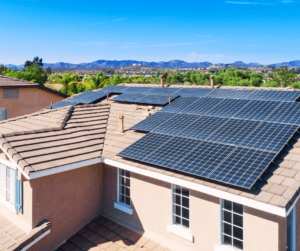
Solar For Home
A home with an average bill of $200 a month will pay over $100,000+ in electricity to power the home for the next 25 years. We can help to reduce that cost.

Solar For Business
Solar may be the perfect solution for business owners looking to reduce their overhead or stabilize their power costs.
Energy Efficiency Company
Mint Energy is a global leader in energy efficiency products. Unlike many solar companies, we manage your project from design to installation and beyond. Our patented graphene solar panels generate 20% to 40% more power compared to standard panels and come with an industry-leading 30-year warranty.
In addition to photovoltaic modules, we also offer Graphene Floor Heating film, Electric Vehicle Chargers, Solar Lamps, Smart Home switches, and more.
Committed to delivering the highest quality products and professional service, our mission is to educate homeowners and businesses on how they can take control of their energy needs, make informed decisions, and achieve the greatest long-term value and benefits for themselves and their families or organization.
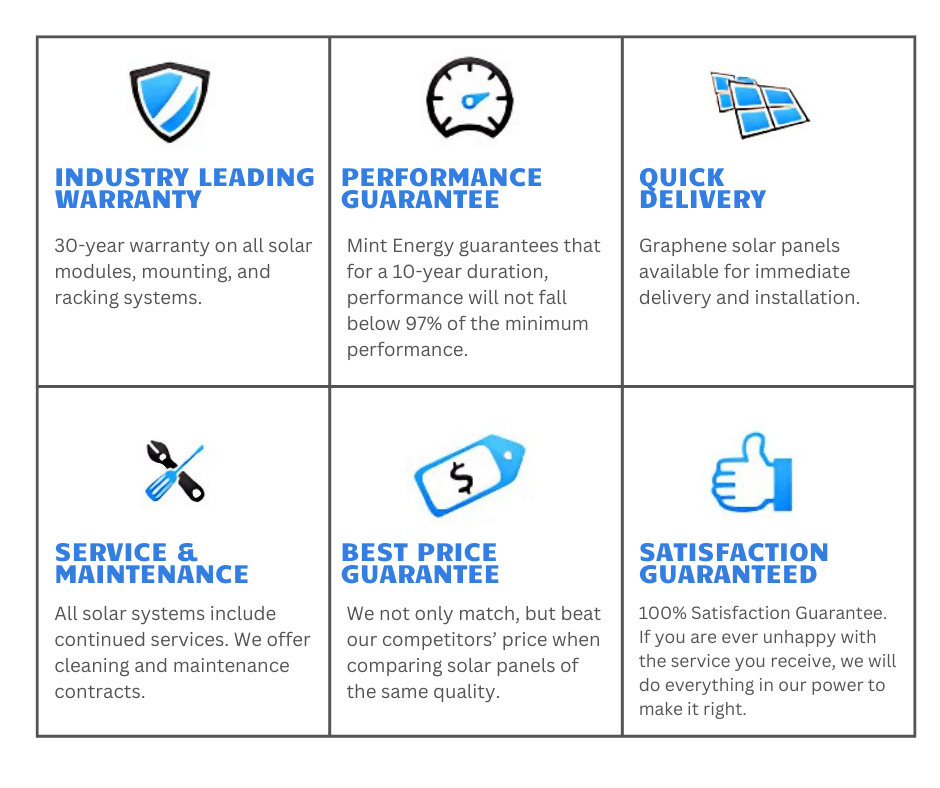
Recent Installations

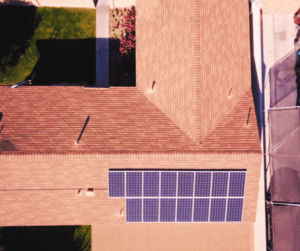
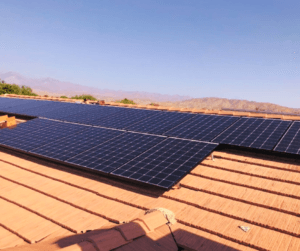
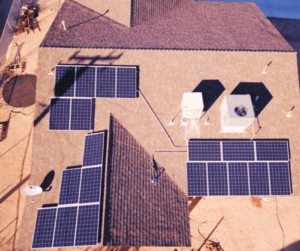

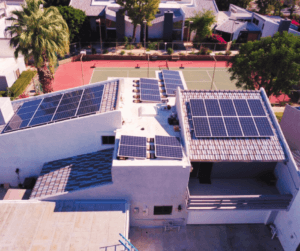
More Energy
The first generation of graphene solar modules is a class of its own. Made exclusively of monocrystalline silicon cells and a layer of graphene deposited on them, they were built to achieve high efficiency and reliable durability enabling it to withstand even the most difficult weather conditions. The use of 12 microwires placed on the surface of a monoatomic graphene photovoltaic cell enables the panel to obtain millions of electrically conductive connections. The slim structure allows the cell to capture the sun’s rays for an additional hour, resulting in the generation of around 20% to 30% more energy when compared to modules produced using standard technology.

More Efficiency
Our Graphene Solar Panels use a monoatomic layer of graphene on silicon plus busbars to allow for a much larger number of connection points. This results in a significant increase in energy efficiency. Nine independent zones enhance the efficiency of the modules and eliminate many obstacles typical to the operation of solar cells.
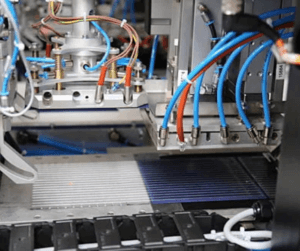
More Benefits
- Increased efficiency of photovoltaic panels and system by approximately 20-30%.
- Reduced susceptibility to microcracks.
- +100% Reduced sensitivity to shading.
- Reduced cost per kWh of energy produced.
- Elimination of the use of harmful chemical compounds in the production of modules.
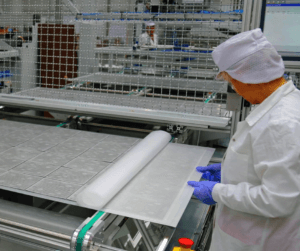
Frequently Asked Questions
What is the difference between an AC and DC solar energy system? Which is better for my house?
All photovoltaic solar energy systems are DC (Direct Current). In order for the power generated by the panels to be used in our homes, it must be converted to AC (Alternating Current) through an inverter. DC systems have one or more large inverters that are typically installed near the home’s main electrical panel. In contrast, the systems known as AC use one “microinverter” for each panel installed. Unless a home has significant shading issues, DC systems are usually more efficient and cost-effective.
What is Net Metering?
Net Metering is a billing mechanism that credits homeowners with solar power for the electricity they send to the grid. For example, a home’s solar system may generate more electricity than is used during daylight hours. The excess power is returned to the grid and the homeowner is credited for it. At night, or during times when system output does not meet a home’s energy requirements, the home draws its power from the grid. Customers are billed only for their “net” energy use. On average, only 20-40% of a solar energy system’s output ever goes into the grid. This exported solar electricity serves nearby customers’ needs.
Some utilities bill homeowners monthly while others do it on an annual basis. Homeowners who use more power than they generate will receive a bill. If they generate more power than they use, they will earn a credit from the utility or in some cases a check. Each utility is different. Please ask your energy consultant to explain the Net Metering options for your utility.
Should I lease or purchase my solar system?
In almost all cases, it is better to purchase a solar energy system rather than lease. When you purchase a solar energy system, even if you finance it, you are eligible to receive a 30% federal tax credit on the total cost. You are not eligible to receive this credit when you lease the system. If you have questions regarding the tax credit, please consult your tax professional.
Owning a system also increases the value of your home. If you purchase the system with cash, the payback period will usually be between five and seven years. If you finance a system, you will typically have a monthly payment that is significantly lower than what you pay your utility. Most homeowners choose a term from 12 to 20 years. With modern solar systems expected to last 30 to 50 years, your solar energy system will continue to provide your home with power for years after you have paid it off.
The only scenario in which leasing a system makes more sense than owning it is if a homeowner has no tax liability. This could be because they are on a fixed income or are not a US citizen. Even if a homeowner has only a small tax liability, it makes more sense to own.
Is the quality of a solar panel really that important?
Some solar companies try to sell homeowners on the idea that one brand of panel is as good as any other for installation on their home. Despite what they may tell you, product quality is critical to the performance of your installation and your rate of return on investment.
The best measure of the quality of a solar panel is in its degradation rate. Initially, most solar systems are able to generate the power that they are designed to produce, but all solar panels degrade over time. The rate at which they degrade is what separates high-quality panels from those that are less so. Why does this matter? As the panels degrade, they will produce less power. To compensate for this reduced production, the homeowner will be forced to buy more power from the utility — and buy it at higher prices every year.
The graphene solar panel’s degradation rate is an industry-leading 0.3% per year, meaning that after 30 years, our solar energy system will still be producing 91% of its nominal power.
What is the offset and why is it important?
Offset is the percentage of the homeowner’s energy needs that are covered by their solar system. Most systems are designed to meet 100% of the homeowner’s needs, beginning with their historical usage and adjusted according to a thorough evaluation of any expected future changes. The system is sized accordingly. While it is impossible to predict exactly how much power will be used from year to year, it is important to get as close as possible. If the system is too large, the homeowner pays more than necessary for solar power. Conversely, if the system does not produce all of the energy required, the homeowner ends up buying power from the utility — at rates that are rising every year.
Ready to start your project?
Contact us to start with a demo unit for your needs at sales@mintenergy.com
